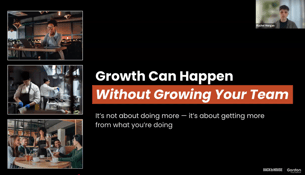As a brick-and-mortar business, you're nowhere until you're on Google Maps. The ubiquitous mapping platform has ranked among the world’s most-downloaded apps since the invention of the smartphone. While other flavor-of-the-year apps might see more downloads at a given moment, Google Maps steadily remains probably the planet’s most popular use of GPS, answering all sorts of geographical questions, in all sorts of places.
More than a billion people a month use the platform. Many of them want to check for traffic jams on the way to grandma’s house. Others want to know the quickest bike route to the beach. You and your restaurant are probably most interested in another key demographic: the folks who fire up Google Maps, in their neighborhood or in some exotic locale, and simply type the word “lunch.”
While business owners obsess over where their website ranks on certain Google results, they might overlook the enormous customer base on Google Maps, a platform that offers some distinct advantages over regular Google searches. For one, you don’t exactly “rank” on a map: Your business exists in a place, or it doesn’t. So the question becomes imperative for your restaurant, of how to ensure that Google Maps knows where to find you, across any relevant set of search terms.
If you’re reading this right now, you definitely exist. Here’s how to leverage local SEO to make sure Google agrees.
Your Google Maps footprint comes from your Google Business Profile
Google Maps seems to know so much because business owners like you tell it what’s up. Greg Gifford, an expert on local search, recommends that business owners create a free Google Business Profile (GBP), which will relay to Google the info that will feed your Google Maps results.
Your restaurant’s GBP includes such at-a-glance information as your website address, Google Reviews, and other essentials. Without a Business Profile, don’t expect much from your Maps ranking.
“The Google Business Profile is going to be extremely important to restaurants” trying to maximize Google Maps, Gifford said.
The search benefits of GBP don’t stop there. When someone searches using local keywords, Google could display your business in at least three different ways beyond a normal search result, all pulling from your Google Business Profile.
“It's not like there's one algorithm powering search results, no matter where you are in Google,” Gifford said. Instead, Google may discern that a search has what Gifford calls “local intent” that will surface results in an area that a user designates — or simply where they are as they search — as well as which Google tool the person uses for the search.
In short, your results within Maps won’t look exactly like the results within a regular Google search. You’ve probably encountered these variations on different searches of your own. A general search for a type of location in a specific area — say, “barbecue austin texas” — returns the Google local pack, three local results, and a map with pins on a handful of barbecue joints.
Click a point on map to find the local finder page, search results that include a map but which differ from the results when you search the same thing at maps.google.com. Results for each depend on what Google perceives as the user’s intent, Gifford said. Conducting the search within Google Maps signals to Google that a user isn't simply doing research, but is interested in going. Which is what makes those results so powerful for restaurants.
Optimize your Google Business Profile to drive local results
The physical location of the person doing the search also affects results. Google recognizes that specific searches may expect results that are as local as possible.
“If you just type in ‘pizza delivery,’ you're going to get a list of pizza delivery spots that are near your current location,” Gifford said. “If you do it at your office versus at your house, even though you type the same two words and didn't specify a location, you get two vastly different search results. Because Google knows you need that delivered from nearby.”
Using your GBP you should tune up the info Google displays about your restaurant, to help out folks who are searching with an intent to visit. The basics: address, phone number, hours of operation, and a few pictures. Often, a fully updated GBP can even be more important than your restaurant website for search ranking. Be thorough, be specific, and leave no relevant category blank.
“The categories that you select are really important,” Gifford said. “There are a lot of people out there that will just select the category ‘restaurant.’ Using Italian restaurants as an example, there is a category for Italian restaurants, that would be what you should pick for your primary category.”
By now you probably realize your GBP is not a set-it-and-forget-it project. Info from Google Reviews, delivery options, Covid precautions, and user-generated questions require periodic attention. Local search and Maps results will display particular parts of your GBP. To see your entire profile, just search your restaurant’s name.
Your GBP can also provide you, as the business owner, such actionable data as website clicks, directions requests, search impressions, and “discovery search” impressions, which are instances when people find your restaurant from a related search. That data can help you improve the information you’re providing Google and also target your marketing to match how people are finding your restaurant.
“I'm looking for, ‘Hey, I need Italian food,’ and Carrabba’s pops up, then I get that impression,” Gifford said. “That's a discovery search because I wasn't looking for them by their brand. I'm looking for them for something related to what they do.”
Gifford also suggests leveling up your GBP by using a trackable phone number specific to your Google Business Profile, to see how many calls you’re getting via those search results.
Getting ahead of user-generated responses that may appear in your profile can also make sure potential customers know your restaurant cares about their opinions. Log into your GBP and answer questions from the discussion widget built into the Google results. Owners can also supply their own questions to anticipate common inquiries from new customers.
“You want to pay attention to what's there and make sure that you're answering,” Gifford said. “When the restaurant answers, it'll say it's from the restaurant and will put ‘Owner’ in parentheses. And that's a better experience for people.”
Social and web links don’t affect your local SEO or Google Maps
Now for some good news: Aside from keeping on top of your GBP, we’re not assigning you extra work.
The finest Instagram, Facebook, and TikTok posts in the history of restaurants don’t factor into Google’s algorithms. Your amazing social media strategy might put you on the proverbial map, sure. But if your goal is to appear on Google Maps, you don’t have to worry about social.
Likewise, the quality and optimization of your restaurant’s website certainly affects how Google will surface it in normal search results. For Google Map results, though, not so much. Aside from your GBP, your results on Google Maps are largely out of your control.
That might be frustrating if you’re brilliant at SEO and at social media, but for most smaller restaurant operators, it probably comes as a relief. When you’re weighing whether to invest your time into your website and social channels or into your GPB, the winner is clear if you want to rule your local search results. “The Google Business Profile,” Gifford said, “is more important.”





